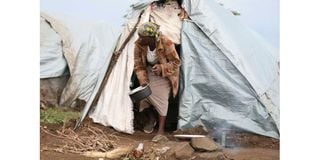Poll-related GBV: How prepared are the counties?

An internally displaced woman Trans Nzoia County where 255 families lived in 2011 following post-election violence. More than 3,000 women suffered sexual violence in 2007/08 post-poll chaos according to Covaw, an NGO.
What you need to know:
The National Crime Research Centre research on the spike of GBV established that of the 2,416 cases reported between January and June, 2020, 71 per cent were against women and girls.
These cases represented a 92.2 per cent increase in GBV from the January and December, 2019 period.
For the first two years that Covid-19 stung Kenya, gender-based violence (GBV) ravaged homes with women and girls carrying the larger share of the violence.
Already, government data puts a GBV lifetime prevalence for women at 38 per cent compared to 20.9 per cent of men.
Following the directive of President Uhuru Kenyatta, National Crime Research Centre conducted research on the spike of GBV.
The agency established that of the 2,416 cases reported between January and June, 2020, 71 per cent were against women and girls and 29 per cent were those reported relating to violation of men and boys.
These cases represented a 92.2 per cent increase in GBV from the January and December, 2019 period.
Of the most common forms of GBV were physical assault, rape or attempted rape, murder and sexual offences.
Others were defilement, grievous harm, physical abuse, child marriages, psychological torture, and child neglect.
Data from the 1195 and Fida Kenya, consistently put five counties on the list of regions with high prevalence rates.
These were Nairobi, Kisumu, Nakuru, Kiambu and Kakamega.
This injustice repeated itself in 2017. International Federation for Human Rights and Kenya Human Rights Commission documented 51 cases of women survivors in Vihiga, Migori and Kisumu counties.
Combining the already high GBV prevalence rates and survivors carrying the scars of the election-related sexual violence, makes Kenya a fragile ground for all gender.
Hence, a need for a robust and effective mechanism to prevent the occurrence of new cases as we apprtoach the August 9, General Election. And response structures that are seamless and non-victimising.
In her speech on June 8, at the GBV prevention and response scientific conference held at Kenya School of Government – Kabete Campus, Council of Governors CEO Mary Mwiti, said counties were well prepared to tackle the crime.
She said the counties have set up rescue centres and shelters for short-term care and rehabilitation of survivors. She, however, did not identify the counties in which these social investments have been made.
On facilitating easy access to contraception and HIV post-exposure prophylaxis emergency care, she said counties have brought GBV clinical services to lower-level health facilities.
This is coupled with raising awareness on the prevention of violence against all gender





